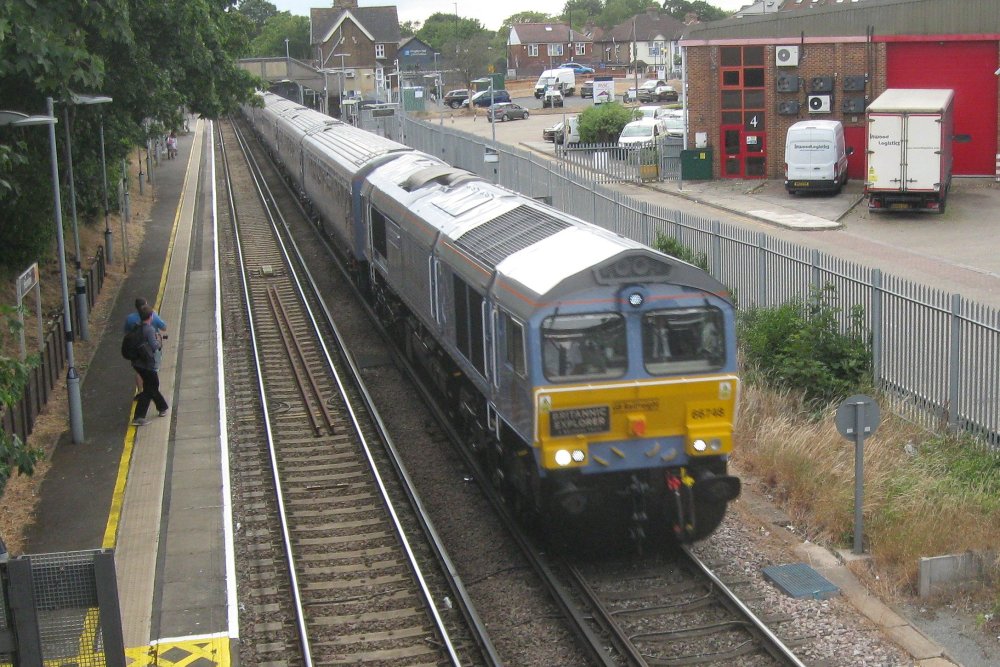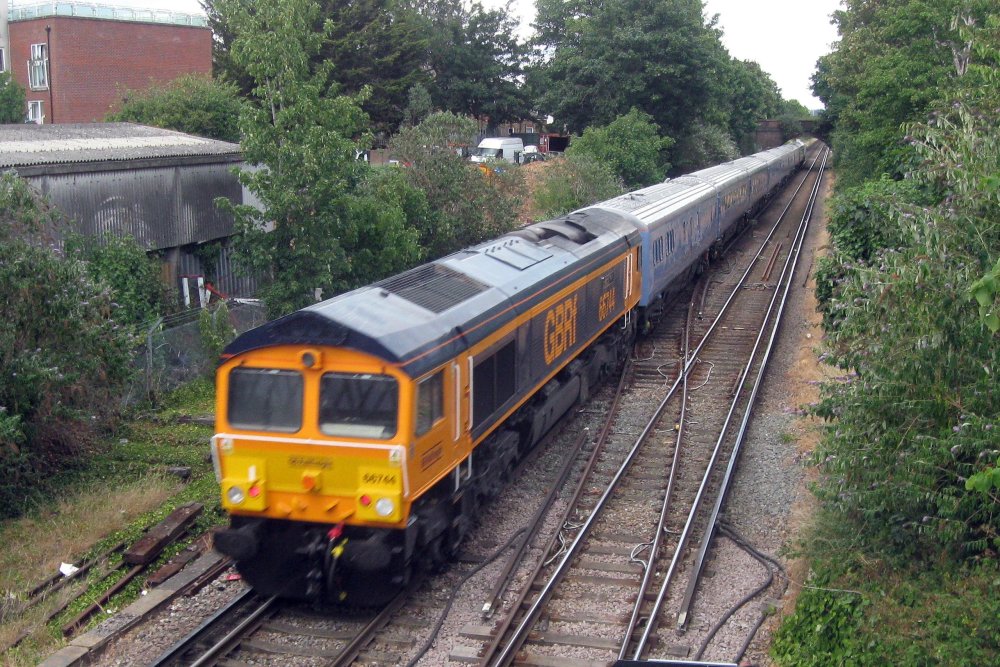
Brendan8056
Members-
Posts
51 -
Joined
-
Last visited
-
Days Won
1
Brendan8056 last won the day on July 3
Brendan8056 had the most liked content!
Personal Information
-
Location
Hounslow. Middlesex.
Converted
-
Interests
4mm scale 21mm gauge
Recent Profile Visitors
The recent visitors block is disabled and is not being shown to other users.
Brendan8056's Achievements
-
When the Murphy Irish Mk3s eventually appear they can add another livery variation, and sell to UK modellers as well. The Belmond Brittanic Explorer. This evening the train headed through my local station from Eastleigh railway works. I never thought an "Irish" train would go through Hounslow! Perhaps a link up with Accurascale for the lead class 66?
-
I had some dealings with this company when it was "Bill Bedford" models, and took my deposit for an RTR WT class tank loco, that never appeared. Most of my deposit never re-appeared though he did accept some of it as payment for some etched sides and some 21mm gauge brass fold up wagon W irons. In the world of small scale model railway manufacture this can happen, some great modelmakers but terrible businessmen! I feel Horsetan is right, only buy from the sales stand, do not try ordering in advance, as the item may never be produced. Mousa Models certainly wins awards for the vaguest website.
-
IRRS London Zoom Meeting with Jonathan Beaumont
Brendan8056 replied to leslie10646's topic in What's On?
Jonathan's presentation was superb, 400,000 cattle a year, from one station on a branch line! I will be buying the book. Thanks Leslie and the IRRS London area for organising the meeting. -
How strange this topic appears and yesterday at the Maidenhead (UK) model railway show I was talking to someone who said he was doing Irish with HO scale and had already done a cab master to make moulds for 141/181/071 cabs and used regauged tenshodos, of which he has many spare ones. They already model EM it appears, so they were not concerned about the oversize track. It seems they are an occasional visitor to this site. Who knows a post may appear at a future date with progress?
-
Provincial Wagons CIE cattle wagon - 21mm gauge advice needed
Brendan8056 replied to Mol_PMB's question in Questions & Answers
I have not done any of Leslie's cattle wagon kits but if the chassis is the same general design as the H van and Bulleid opens wagons he used to do then they can be easily built as 21mm. just use a fine razor saw to remove each axlebox/springs from the chassis and use superglue to secure to the solebar. It also make the wagon look wider, which is what us Irish modellers want anyway. You will also need to widen the space for the wheels to go, just us a file on the resin chassis. Attached a couple of pics which may be helpful. Enjoy assembling them, Provincial kits are easy to get great results with. -
"Voiding the Warranty" - Mol's experiments in 21mm gauge
Brendan8056 replied to Mol_PMB's topic in Irish Models
Welcome back to the world of Irish modelling. I have posted various bits here about re-gauging to 21mm. Rather than repeat myself you can hopefully search for my posts. Also I would suggest subscribing to "New Irish Lines", if you have not already done this. The latest releases from IRM and Murphy Models are 21mm friendly. As David Holman does, I also make my own axles using a drill and some files, very little skill is needed, if I can do it. -
I wish my part of Hounslow had curry smells, sadly I am downwind of Mogden sewage works. Really well done, as are all your projects. those Peco laser cut houses do seem really good value.
-
IRM Is Sucking Diesel As Fuel Oil Tank Wagon Announced
Brendan8056 replied to Warbonnet's topic in News
Colin R, no problem at all. They have the same chassis as the corrugated opens. Conversion to 21mm is easy, it takes about 10 minutes, including moving the brake shoes out. Before and after views of open wagons side by side.. Of course the flats and all the vans will use this chassis as well. Well done IRM on the superb and clever design. -
I am getting old and forgot the local route, it is a mile from where I live. Just take the Piccadilly Line all the way from Heathrow to Kings Cross/St Pancras. The bonus is a ride on the 1973 tube stock.
-
Good Morning, I would not use "Heathrow Express", I believe they still charge premium fares for a 10 minute quicker journey,. Use the "Elizabeth Line" instead, then Circle/Hammersmith and City lines, but expect long walks at Paddington and St Pancras as the signage deliberately sends you on long routes to "control passenger flow". There are also Dover trains 2 per hour from London Victoria to Dover, but these trains now take at least 2 hours, they were slowed down to make the St Pancras trains look faster (seriously, extra stops and slower speeds), likewise the London Bridge services. Unless your tour operator has sorted transport at Dover Priory I don't think there is any bus service to the cruise line terminal. Apart from what I have just said above, enjoy the holiday!
-
It's a B4/B5 bogie, viewed from underneath. The brake bits are push fit, but the factory may have put a dab of glue on them? For 21mm you would need to reposition them, and that would require glue to hold in place. I should add that nothing I have done affects the running of the bogie or the pick ups for the lighting.
-
If it helps with the re-gauge discussion I just took the easy route (P4 modellers look away). The pic has before and after wheelsets. Take the half axles, put pinpoint side upwards in a vice, and use a few taps of a hammer or similar object to push the axle down, leaving just enough to allow the wheels to slot back in. Join the pair of half axles with the plastic sleeve, use a wheel gauge and all is done bar putting the wheels back in the bogie frame. Works for me, and the lads on IRM/Accurascale stand at Alley Paley seemed to like it as well. (The Bulleid opens looked lovely, and have 28mm length axles, ready for proper gauge modelling) You do have to discard the brake blocks, but if needed you could probably glue them in place.
-
To regauge or not to regauge that is the question
Brendan8056 replied to TippTrainLad's topic in General Chat
Like John I have modelled 21mm Irish for 30 plus years and would not go back to the very narrow 16.5mm. I have just worked out how to easily re-gauge the NIR coaches just released (where fitted with the Irish bogie). A small vice, an object to hammer with and a wheel gauge to make sure it is correct. The result is in the picture, one wheelset at correct 21mm gauge. I had to remove the brake blocks/links but otherwise all runs freely. For anyone new to Irish Railway modelling it is the easiest ever to model the correct gauge, of course you can still kitbash, scratchbuild and modify, that is the fun side of it. -
When I say the only mobile phone I have is the works one, and it is only switched on when I am at work, people stare strangely at me. The same look as when I tell them I have never owned a car or a microwave oven.
-
Irish Railway Modelling Circle newsletter
Brendan8056 replied to Flying Snail's topic in General Chat
Hello, " New Irish Lines" is superb as ever. the website does appear to be offline. I would suggest you try emailling Alan O'Rourke. alanorourke@hotmail.co.uk. Anyone who is serious about Irish Railway Modelling should consider subscribing, I always find every edition inspiring and interesting. Lots on this forum write articles for it.
.png.c363cdf5c3fb7955cd92a55eb6dbbae0.png)






